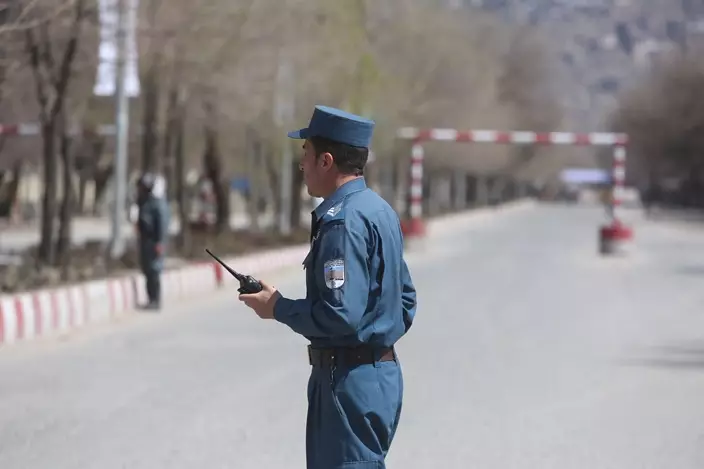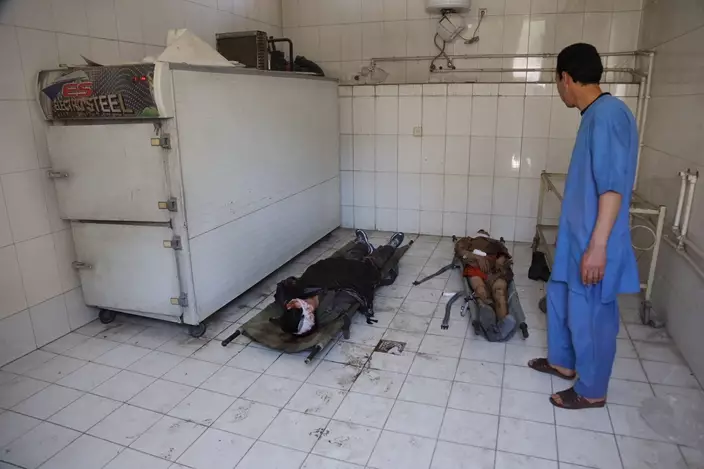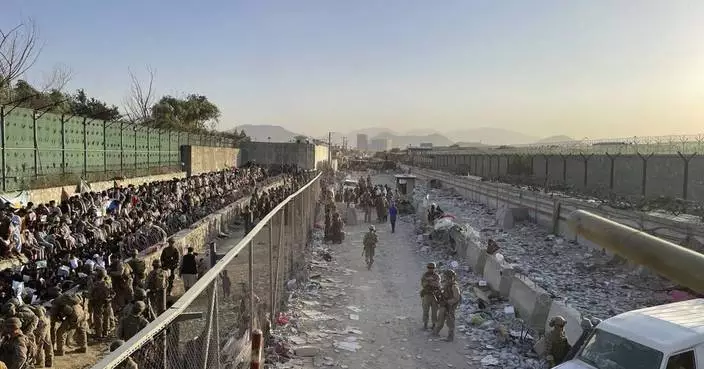An Islamic State group suicide bomber struck on the road to a Shiite shrine in Afghanistan's capital on Wednesday, killing at least 33 people as Afghans celebrated the Persian new year, authorities said.

Police stand guard in the street after a suicide attack in front of the Kabul university in Kabul, Wednesday, March 21, 2018. Afghan officials are reporting a large explosion on the road to a Shiite shrine in the capital, where people had gathered to mark the Persian new year. (AP Photo/ Rahmat Gul)
Wahid Majro, spokesman for The Public Health Ministry, said 65 others were wounded in the attack, which was carried out by a bomber on foot.
IS claimed responsibility in an online statement, according to the SITE Intelligence Group, which monitors jihadi websites. The group said the attack targeted "a gathering of Shiites celebrating Nowruz."

Bodies of civilians lie on the ground at hospital after a suicide attack in front of the Kabul university in Kabul, Wednesday, March 21, 2018. Afghan officials are reporting a large explosion on the road to a Shiite shrine in the capital, where people had gathered to mark the Persian new year. (AP Photo/ Rahmat Gul)
The Persian new year, known in Afghanistan as Nowruz, is a national holiday, and the country's minority Shiites typically celebrate by visiting shrines. The Sunni extremists of IS have repeatedly targeted Shiites, who they view as apostates deserving of death.
The attack took place near Kabul University and a government hospital, around one kilometer (mile) away from the Sakhi shrine, where people were gathered to celebrate the new year, said Gen. Daud Amin, Kabul's police chief.

Police patrol the streets after a suicide attack in front of the Kabul university in Kabul, Wednesday, March 21, 2018. Afghan officials are reporting a large explosion on the road to a Shiite shrine in the capital, where people had gathered to mark the Persian new year. (AP Photo/ Rahmat Gul)
Daud said the attacker managed to slip past police checkpoints set up along the road. He said an investigation into the security breach is underway, and that anyone found to have neglected his duties would be punished.
Earlier this month another Islamic State suicide bomber targeted Afghanistan's ethnic Hazaras, killing nine people and wounding 18 others. The bomber blew himself up at a police checkpoint near a gathering of the minority Shiites in western Kabul. The bomber was on foot and was trying to make his way to a compound where the Hazaras had gathered to commemorate the 1995 death of their leader, Abdul Ali Mazari, who was killed by the Taliban.
Kabul has recently seen a spate of large-scale militant attacks by both the Taliban and the Islamic State group. In late January, a Taliban attacker drove an ambulance filled with explosives into the heart of the city, killing at least 103 people and wounding as many as 235.
Afghan President Ashraf Ghani in a statement condemned Wednesday's attack, calling it a "crime against humanity."
The U.N. Security Council condemned "the heinous and cowardly terrorist attack" in the strongest terms and underlined the need to bring the perpetrators, organizers, financiers and sponsors to justice.
U.S. Ambassador to Afghanistan John R. Bass said he was saddened by the "shameful" attack.
"I continue to hope that every citizen of Afghanistan soon will be able to live in peace, without fear of indiscriminate attacks by terrorists who have no respect for human life," he said in a statement. "The United States and its people remain steadfast in their commitment to working with our Afghan partners to combat terrorism and to secure peace in the year ahead. "
U.N. Secretary-General Antonio Guterres also condemned the attack, calling Nowruz "a time of renewal and celebration" when the values of peace and solidarity should be promoted, U.N. spokesman Stephane Dujarric said, adding "those who have organized this attack must be brought to justice."
Despite the attack and loss of lives, people including women and children later came out on the streets, many wearing colorful clothes, and continued to celebrate the holiday.
NEW YORK (AP) — The “miners” who chisel bitcoins out of complex mathematics are taking a 50% pay cut — effectively reducing new production of the world’s largest cryptocurrency, again.
Bitcoin's latest “halving" occurred Friday night. Soon after the highly anticipated event, the price of bitcoin held steady at about $63,907.
Now, all eyes are on what will happen down the road. Beyond bitcoin’s long-term price behavior, which relies heavily on other market conditions, experts point to potential impacts on the day-to-day operations of the asset’s miners themselves. But, as with everything in the volatile cryptoverse, the future is hard to predict.
Here’s what you need to know.
Bitcoin “halving,” a preprogrammed event that occurs roughly every four years, impacts the production of bitcoin. Miners use farms of noisy, specialized computers to solve convoluted math puzzles; and when they complete one, they get a fixed number of bitcoins as a reward.
Halving does exactly what it sounds like — it cuts that fixed income in half. And when the mining reward falls, so does the number of new bitcoins entering the market. That means the supply of coins available to satisfy demand grows more slowly.
Limited supply is one of bitcoin’s key features. Only 21 million bitcoins will ever exist, and more than 19.5 million of them have already been mined, leaving fewer than 1.5 million left to pull from.
So long as demand remains the same or climbs faster than supply, bitcoin prices should rise as halving limits output. Because of this, some argue that bitcoin can counteract inflation — still, experts stress that future gains are never guaranteed.
Per bitcoin’s code, halving occurs after the creation of every 210,000 “blocks” — where transactions are recorded — during the mining process.
No calendar dates are set in stone, but that divvies out to roughly once every four years.
Only time will tell. Following each of the three previous halvings, the price of bitcoin was mixed in the first few months and wound up significantly higher one year later. But as investors well know, past performance is not an indicator of future results.
“I don’t know how significant we can say halving is just yet,” said Adam Morgan McCarthy, a research analyst at Kaiko. “The sample size of three (previous halvings) isn’t big enough to say ‘It’s going to go up 500% again,’ or something.”
At the time of the last halving in May 2020, for example, bitcoin’s price stood at around $8,602, according to CoinMarketCap — and climbed almost seven-fold to nearly $56,705 by May 2021. Bitcoin prices nearly quadrupled a year after July 2016’s halving and shot up by almost 80 times one year out from bitcoin’s first halving in November 2012. Experts like McCarthy stress that other bullish market conditions contributed to those returns.
Friday's halving also arrives after a year of steep increases for bitcoin. As of Friday night, bitcoin’s price stood at $63,907 per CoinMarketCap. That’s down from the all-time-high of about $73,750 hit last month, but still double the asset’s price from a year ago.
Much of the credit for bitcoin’s recent rally is given to the early success of a new way to invest in the asset — spot bitcoin ETFs, which were only approved by U.S. regulators in January. A research report from crypto fund manager Bitwise found that these spot ETFs, short for exchange-traded funds, saw $12.1 billion in inflows during the first quarter.
Bitwise senior crypto research analyst Ryan Rasmussen said persistent or growing ETF demand, when paired with the “supply shock” resulting from the coming halving, could help propel bitcoin’s price further.
“We would expect the price of Bitcoin to have a strong performance over the next 12 months,” he said. Rasmussen notes that he’s seen some predict gains reaching as high as $400,000, but the more “consensus estimate” is closer to the $100,000-$175,000 range.
Other experts stress caution, pointing to the possibility the gains have already been realized.
In a Wednesday research note, JPMorgan analysts maintained that they don’t expect to see post-halving price increases because the event “has already been already priced in” — noting that the market is still in overbought conditions per their analysis of bitcoin futures.
Miners, meanwhile, will be challenged with compensating for the reduction in rewards while also keeping operating costs down.
“Even if there’s a slight increase in bitcoin price, (halving) can really impact a miner’s ability to pay bills,” Andrew W. Balthazor, a Miami-based attorney who specializes in digital assets at Holland & Knight, said. “You can’t assume that bitcoin is just going to go to the moon. As your business model, you have to plan for extreme volatility.”
Better-prepared miners have likely laid the groundwork ahead of time, perhaps by increasing energy efficiency or raising new capital. But cracks may arise for less-efficient, struggling firms.
One likely outcome: Consolidation. That’s become increasingly common in the bitcoin mining industry, particularly following a major crypto crash in 2022.
In its recent research report, Bitwise found that total miner revenue slumped one month after each of the three previous halvings. But those figures had rebounded significantly after a full year — thanks to spikes in the price of bitcoin as well as larger miners expanding their operations.
Time will tell how mining companies fare following this latest halving. But Rasmussen is betting that big players will continue to expand and utilize the industry’s technology advances to make operations more efficient.
Pinpointing definitive data on the environmental impacts directly tied to bitcoin halving is still a bit of a question mark. But it’s no secret that crypto mining consumes a lot of energy overall — and operations relying on pollutive sources have drawn particular concern over the years.
Recent research published by the United Nations University and Earth’s Future journal found that the carbon footprint of 2020-2021 bitcoin mining across 76 nations was equivalent to emissions of burning 84 billion pounds of coal or running 190 natural gas-fired power plants. Coal satisfied the bulk of bitcoin’s electricity demands (45%), followed by natural gas (21%) and hydropower (16%).
Environmental impacts of bitcoin mining boil largely down to the energy source used. Industry analysts have maintained that pushes towards the use of more clean energy have increased in recent years, coinciding with rising calls for climate protections from regulators around the world.
Production pressures could result in miners looking to cut costs. Ahead of the latest halving, JPMorgan cautioned that some bitcoin mining firms may “look to diversify into low energy cost regions” to deploy inefficient mining rigs.

FILE - An advertisement for the cryptocurrency Bitcoin displayed on a tram, May 12, 2021, in Hong Kong. Sometime in the next few days or even hours, the “miners” who chisel bitcoins out of complex mathematics are going to take a 50% pay cut — effectively slicing new emissions of the world’s largest cryptocurrency in an event called bitcoin halving. (AP Photo/Kin Cheung, File)











